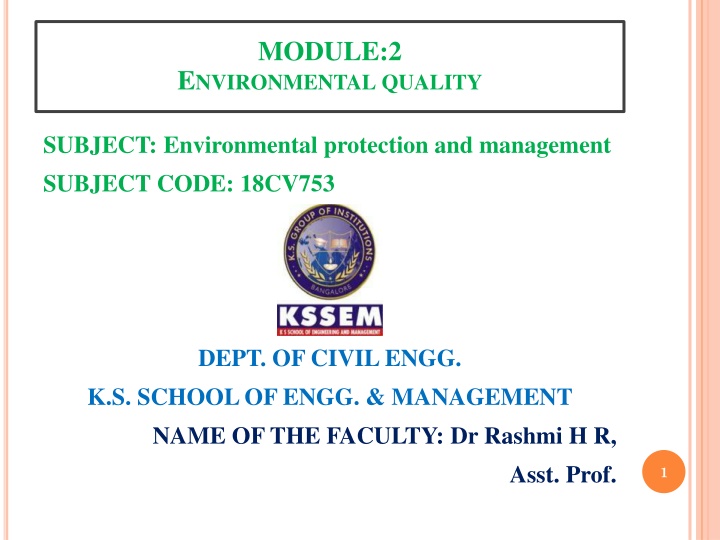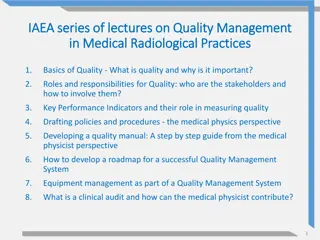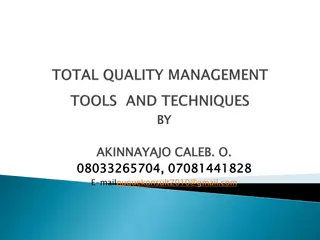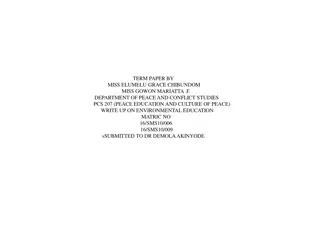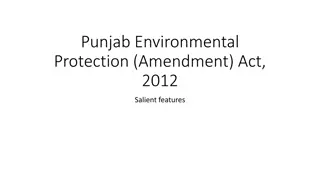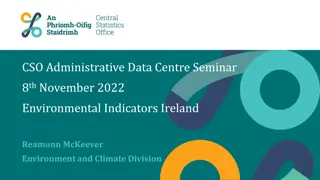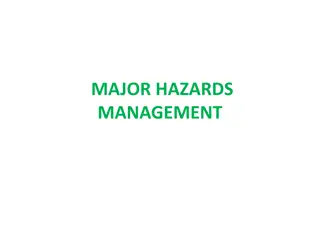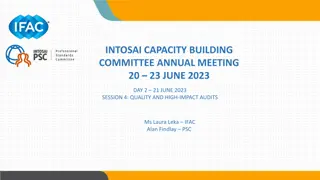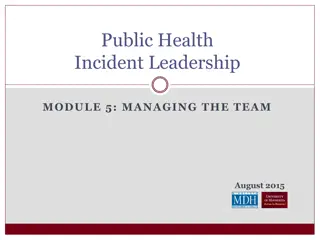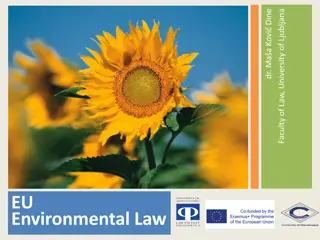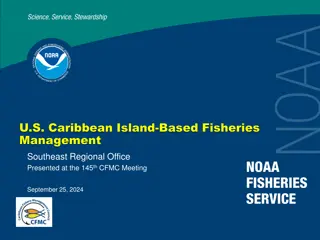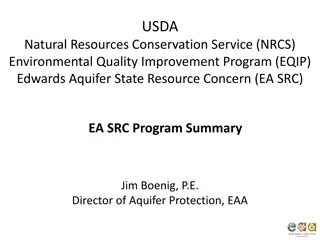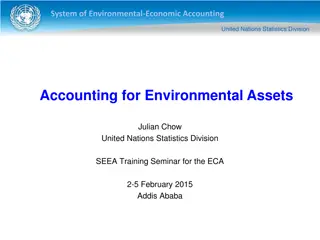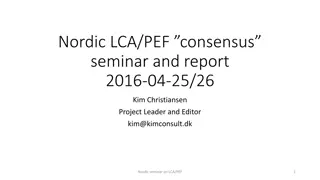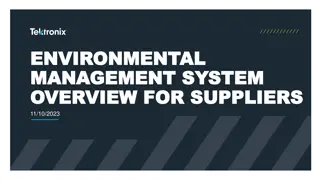Environmental Quality Management and Objectives
This content delves into the importance of environmental protection and management, focusing on standards, pollution control, cleaner production, environmental strategy, and the objectives of environmental quality management. It emphasizes the need for compliance with regulations, minimizing environmental damage, efficient use of resources, and protecting biodiversity. Additionally, it highlights the long-term benefits for companies in improving financial results, reputation, and employee retention through environmental initiatives.
Download Presentation

Please find below an Image/Link to download the presentation.
The content on the website is provided AS IS for your information and personal use only. It may not be sold, licensed, or shared on other websites without obtaining consent from the author.If you encounter any issues during the download, it is possible that the publisher has removed the file from their server.
You are allowed to download the files provided on this website for personal or commercial use, subject to the condition that they are used lawfully. All files are the property of their respective owners.
The content on the website is provided AS IS for your information and personal use only. It may not be sold, licensed, or shared on other websites without obtaining consent from the author.
E N D
Presentation Transcript
MODULE:2 ENVIRONMENTALQUALITY SUBJECT: Environmental protection and management SUBJECT CODE: 18CV753 DEPT. OF CIVIL ENGG. K.S. SCHOOL OF ENGG. & MANAGEMENT NAME OF THE FACULTY: Dr Rashmi H R, Asst. Prof. 1
MODULE 2 Environmental quality objectives Rationale of Environmental standards: Concentration and Mass standards, Effluent and stream standards, Emission and ambient standards, standards, environmental performance evaluation: Indicators, benchmarking. Pollution control Vs Pollution Prevention - Opportunities and Barriers Cleaner production and Clean technology, closing the loops, zero discharge technologies -8 Hours Minimum national 2
ENVIRONMENTAL MANAGEMENT Environmental management and its strategy - Characterized by long-term objectives and Business areas (Company wants to be active and tries to obtain the necessary resources in order to succeed in the competitive environment) 3
Environmental strategy means Compliance with the obligations set by the applicable legislation and Voluntary decision of the company to mitigate its impact on the environment. 4
AIMOFENVIRONMENTALMANAGEMENT To minimize the damage caused to the environment To reduce the amount of waste An efficient use of natural resources Protection of biodiversity Climate and others 5
INTHELONGERRUN Companies may profit from a range of other benefits Improvement of the financial results Enhancing company reputation Recruiting new and retaining the existing employees (- To build a strong position of the enterprise on the market - To acquire new business opportunities -To reduce costs in the individual areas of its business activities) 6
ENVIRONMENTAL QUALITY OBJECTIVES 1) Reduced Climate Impact 2) Clean Air 3) Natural Acidification only 4) A Non-Toxic Environment 5) A Protective Ozone Layer 6) A Safe Radiation Environment 7) Zero Eutrophication 8) Flourishing Lakes and Streams 7
OBJECTIVESCONT. 9) Good-Quality Groundwater 10) A Balanced Marine Environment, Flourishing Coastal Areas 11) Thriving Wetlands 12) Sustainable Forests 13) A Varied Agricultural Landscape 14) A Magnificent Mountain Landscape 15) A Good Built Environment 16) A Rich Diversity of Plant and Animal Life 8
1. REDUCED CLIMATE IMPACT The UN Framework Convention on Climate Change - stabilization of concentrations of greenhouse gases in the atmosphere at level - ensure that human activities do not have a harmful impact on the climate system Goal achieved - biological diversity is preserved, food production is assured and other goals of sustainable development All countries, must have responsibility for achieving global objective 9
2. CLEAN AIR The air must be clean enough not to represent a risk to health or to animals, plants or cultural assets 10
3. NATURAL ACIDIFICATION ONLY Acidifying effects of deposition and land use must not exceed the limits that can be tolerated by soil and water. Deposition of acidifying substances must not increase the rate of corrosion of materials or cultural artefacts and buildings 11
4. A NON-TOXIC ENVIRONMENT The environment must be free from man-made or extracted compounds and metals that represent a threat to human health or biological diversity 12
5. A PROTECTIVE OZONE LAYER The ozone layer must be replenished so as to provide long-term protection against harmful UV radiation 13
6. A SAFE RADIATION ENVIRONMENT Human health and biological diversity must be protected against the harmful effects of radiation in the external environment 14
7. ZERO EUTROPHICATION Nutrient levels in soil and water Adversely affect human health Biological diversity Possibility of varied use of land and water use 15
8. FLOURISHING LAKESAND STREAMS Lakes and watercourses must be ecologically sustainable and its variety of habitats must be preserved Natural productive capacity, biological diversity, cultural heritage assets and the ecological and water-conserving function of the landscape must be preserved, at the same time as recreational assets are safeguarded 16
9. GOOD-QUALITY GROUNDWATER Groundwater must provide a safe and sustainable supply of drinking water 17
10. A BALANCED MARINE ENVIRONMENTAND FLOURISHING COASTAL AREAS The sustainable productive capacity, and biological diversity must be preserved Coasts must be characterized by a high degree of biological diversity and a wealth of recreational, natural and cultural assets Industry, recreation and other utilization of the seas, coasts must be compatible with the promotion of sustainable development Particularly valuable areas must be protected against encroachment and other disturbance 18
11. THRIVING WETLANDS The ecological and water-conserving function of wetlands in the landscape must be maintained and valuable wetlands preserved for the future 19
12. SUSTAINABLE FORESTS The value of forests and forest land for biological production must be protected, at the same time as biological diversity and cultural heritage and recreational assets are safeguarded 20
13. A VARIED AGRICULTURAL LANDSCAPE The value of the farmed landscape and agricultural land for biological production and food production must be protected, at the same time as biological diversity and cultural heritage assets are preserved and strengthened 21
14. A MAGNIFICENT MOUNTAIN LANDSCAPE The pristine character of the mountain environment must be largely preserved, in terms of biological diversity, recreational value, and natural and cultural assets Activities in mountain areas must respect these values and assets, with a view to promoting sustainable development Particularly valuable areas must be protected from encroachment and other disturbance 22
15. A GOOD BUILT ENVIRONMENT Cities, towns and other built-up areas must provide a good, healthy living environment and contribute to a good regional and global environment Natural and cultural assets must be protected and developed Buildings and amenities must be located and designed in accordance with sound environmental principles and in such a way as to promote sustainable management of land, water and other resources 23
16. A RICH DIVERSITYOF PLANTAND ANIMAL LIFE Biological diversity must be preserved and used sustainably for the benefit of present and future generations Species habitats and ecosystems and their functions and processes must be safeguarded Species must be able to survive in long-term viable populations with sufficient genetic variation People must have access to a good natural and cultural environment rich in biological diversity, as a basis for health, quality of life and wellbeing 24
RATIONALEOF ENVIRONMENTALSTANDARDS Report issued by an expert group on the subject of environmental health should place great emphasis on criteria and standards. Public health are dependent upon standardized values, procedures and substances 25
Examples Motor Vehicle emission authority for other sources of atmospheric pollution Water supply under interstate carriers but not for water used in schools, offices, hospitals etc., Need for functional rather than categorical approach to standards developed Move on set up of standards initiated by Public Health Service - effect from 1 Jan, 1967 26
Authorities includes Public Health Service Bureau of Disease Prevention and Environmental Control Five national centers concerned - air pollution, radiological health, urban and industrial health, communicable disease control, and chronic disease control 27
Statutory authority for developing criteria and enforcing standards for the following Control of air pollution Interstate spread of communicable disease Ionizing radiations Solid wastes Accidental injuries, occupational hazards Pesticides Noise Control of rodents, mosquitoes, and other vectors of disease 28
Extended both within and outside the Public Health Service Determined - protection standard promulgated should meet the characteristics like- study and consultation any health Bureau by 29
CHARACTERISTICS Standard should be truly relevant to the health and well-being of man Should be addressed to the prevention or control of a health hazard or to other statutory responsibilities of the Public Health Service. 30
Standard must be realistic and attainable Standard should employ the best available methods of control under conditions which are economically feasible and which do not constitute unacceptable risks to human health Health protection standards should be attainable within the current state of the art and at a financial cost which is not prohibitive 31
Adherence to the standard should be measurable with reasonable precision and reliability Responsible for enforcing and also those who are required or expected to comply with the standard must be able to ascertain when a violation has taken place 32
Standard should be aggressive in terms of protecting the public health Uncertainties as to the degree of control necessary should, be resolved in that direction which will afford the greater protection to the public 33
Standard should clearly identify the population group it is intended to protect Example: some standards are designed to protect the general population - Some to protect a segment of the population - Some to protect persons living in certain geographic areas - Some to protect workers in certain occupation groups 34
EFFLUENT AND STREAM STANDARDS STREAM PROTECTION MEASURES Methods of maintaining a stream Effluent Standards Stream Standards Effluent Standard: established for the wastewater that has been processed from the units. Stream Standard: The Standard Quality established in accordance with the designation of water bodies The Quality Standards 35
EFFLUENT STANDARDS Effluent standards pertain to the quality of the discharge water itself Based on economics than on absolute protection of the stream Easy to control Detailed stream analysis are not required It do not establish an overall level of pollutant loading for a given water body Ratio of wastewater to stream flow are not considered Treatment is obligatory irrespective of the size of industry 36
For effective protection of an overloaded stream, the effluent standards are required to be upgraded Large industries have an edge over small industry 37
EFFLUENT DISPOSAL STANDARDS TABLE 1: EFFLUENTDISPOSALSTANDARDS Sl.No. CHARACTERISTICS STREAM CLASSIFICATION A B C D E 1 Dissolved Oxygen mg/L (Min) 6 5 4 4 - 2 Biochemical Oxygen Demand mg/L (Max) Total Coliform Organism MPN/100mL 2 3 3 - - 3 50 500 5000 4 Total Dissolved Solids mg/L (Max) 500 - 1500 - 2100 5 Chlorides (as Cl.mg/L (Max.) 250 - 600 - 600 38
STREAM STANDARDS Stream standards refer to the quality of the receiving water downstream from the origin of the wastewater discharge It is based on establishing classification of quality for a stream Quality of the receiving water is regulated to maintain established stream classification Prevention of excessive pollution/ Loading is limited to what the stream can assimilate No consideration of type and location of industry 39
Allows public to establish goals for present and future water quality Confusion of zone of different classification Controversy over proportion of stream to be reserved for future usage (municipal, industrial, agriculture etc.) Opposition from industry/ public to change the established classification 40
A detailed stream analysis is required to determine the level of wastewater treatment required to maintain the health of the ecosystem Cost of treatment may affect the survival of industry 41
STREAM CLASSIFICATION IN INDIA TABLE 2: STREAMCLASSIFICATION DESIGNATED BEST USE CLASS OF STREAM A Drinking Water Source without conventional treatment after disinfection Outdoor bathing Drinking Water with conventional treatment followed by disinfection B C D E Propagation of wild life-fisheries Irrigation, industrial cooling controlled wastewater disposal 42
CONCENTRATIONAND MASS Concentration Concentration is the mass of a pollutant in a defined volume of water Load (Mass) Load is the amount (mass) of a pollutant that is discharged into a water body during a period of time (i.e. tons of sediment per year) Both concentration and load provide information of environmental significance, but each has limitations 43
MINIMUMNATIONALSTANDARDS (MINAS) 1976 CPCB developed concept of evolving industry specific effluent standards Based on comprehensive study of the problems of the industry An attempt was made To identify relevant pollution parameters Its pollution potential Best pollution control technologies available in India 44
MINAS MINAS contemplated a minimum level of treatment for specific industrial wastewater based on Annual turnover of the industry Techno-economic feasibility of the control objective Initially textile and man-made fibers were studied and standards were set Later included oil refineries, chloro-alkali etc., 45
Disposal specificity was not a part of MINAS Standards were considered to be minimum standards that a specific industry should achieve irrespective of the mode of disposal In Environmental Protection Act 1986, some of these standards were incorporated Since these were minimal standards SPCB were permitted to make them only stringent and in no case relax them 46
TWOBASICPROBLEMS Since these standards were not disposal specific , it lead to many anomalous situations Tended to become rather stringent and in many cases almost the maximum achievable standards MINAS are indeed not minimal standards but maximum achievable standards 47
EMISSIONANDAMBIENT STANDARDS Ambient air quality refers to the condition or quality of air surrounding us in the outdoors National Ambient Air Quality Standards are the standards for ambient air quality set by the Central Pollution Control Board (CPCB) that is applicable nationwide. The CPCB has been conferred this power by the Air (Prevention and Control of Pollution) Act, 1981. 48
AMBIENT AIR QUALITY STANDARDSIN INDIA The Air (Prevention and Control of Pollution) Act 1981 was enacted by the Central Government with the objective of arresting the deterioration of air quality The Air (Prevention and Control of Pollution) Act 1981 describes the main functions of the Central Pollution Control Board (CPCB) as follows 49
To advise the Central Government on any matter concerning the improvement of the quality the air and the prevention, control and abatement of air pollution. To plan and to be executed a nation-wide programme for the prevention, control and abatement of air pollution. To provide technical assistance and guidance to the State Pollution Control Board 50
